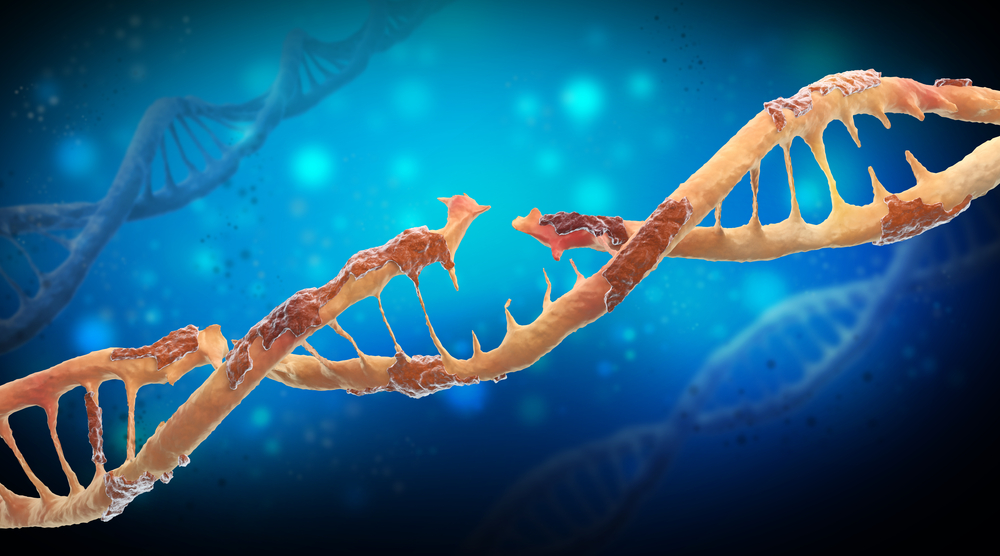PAH May Be Linked to Increased Sensitivity to DNA Damage, Researchers Say

Sensitivity to DNA damage may act as an early trigger of pulmonary arterial hypertension (PAH), according to researchers at the Universitaire de Cardiologie et de Pneumologie de Québec, in Canada. In the study “DNA Damage and Pulmonary Hypertension,” published in the International Journal of Molecular Sciences, researchers reviewed the evidence suggesting that DNA damage and defective DNA repair mechanisms are implicated in PAH development.
Although little is known about the events that lead to the development of PAH, oxidative stress and inflammation are thought to play major roles in promoting vascular remodeling. Because oxidative stress and inflammation are known to favor DNA damage, it is possible that the abnormal cell proliferation observed in vascular remodeling are caused mostly by dysfunctional DNA-damage response mechanisms.
DNA integrity is constantly threatened. Every day, each cell has about 100,000 spontaneous DNA lesions derived mainly from endogenous DNA insults, such as ultraviolet radiation. However, the cell is equipped with highly efficient mechanisms, called DNA-damage response mechanisms, that rapidly detect and repair such mutations. Depending on the type of mutation, different pathways take over the repair process, meaning that hundreds of proteins are involved in maintaining DNA integrity.
The first evidence suggesting that mutations could be involved in the pathogenesis of PAH was reported in 1998. More recently, a study reported that 30.2 percent of pulmonary arterial endothelial cells (PAECs) isolated from PAH patients had chromosomal abnormalities, compared to 5.3 percent in PAECs from control patients. This high rate of mutations was also observed in other cell types isolated from PAH patients, suggesting that they had a predisposed sensibility to DNA damage.
Inflammation is one of PAH hallmarks and it plays a major role in the onset of the disease. Some pro-inflammatory molecules seem to be good indicators of PAH progression. However, inflammation is also involved in DNA damage through the increase of reactive oxygen species (ROS) and reactive nitrogen species (RNS) produced by the endothelial cells.
The increased production of ROS and RNS lead to oxidative stress, which modulates the production of a number of molecules involved in pulmonary hypertension (PH) and PAH. Furthermore, oxidative stress can also lead to inflammation and cell injuries due to oxidation of cellular components, including the DNA molecules.
A number of drugs have also been associated with PAH development. Some molecules used as appetite suppressants, for instance, were found to induce PAH development due to its similarities with amphetamine derivatives, known to induce DNA damage through oxidative stress. Antidepressant treatments are also associated with an increased risk of PAH.
Alkylating chemotherapies are used to treat several cancers by inducing DNA damages to the cancer cells, which have abnormal DNA-damage repair mechanisms. However, healthy cells may also be affected. A recent report consistently revealed an association between the use of alkylating agents and an uncommon form of PAH, possibly by inducing damages in the pulmonary arterial endothelial cells and limiting their DNA-damage repair capacity.
Dysregulation of the mechanisms involved in DNA repair have been identified as a PAH trigger. A number of molecules involved in DNA-damage repair have been shown to be abnormally expressed in the arteries of humans and animal models with the disease.
Similarly, mitochondrial dysfunction has also been linked to PAH. Mitochondrial DNA is more sensitive to damage than nuclear DNA, since their DNA is not protected by a specific class of proteins called histones. Damages in the mitochondrial DNA of PAECs have suggested that a link with PAH may exist.
“All these evidences summarized in the present review support the hypothesis that DNA damage sensitivity may act as an early trigger of PAH,” the authors wrote in their study. “Both nuclear and mitochondrial DDR [DNA-damage repair] are still not well characterized, and crosstalk between them or with other pathological pathways may also be involved in the pathogenesis. Further studies are then required to fully explain how DNA damage and DDR contribute to PAH pathogenesis in order to identify new therapeutic targets.”







